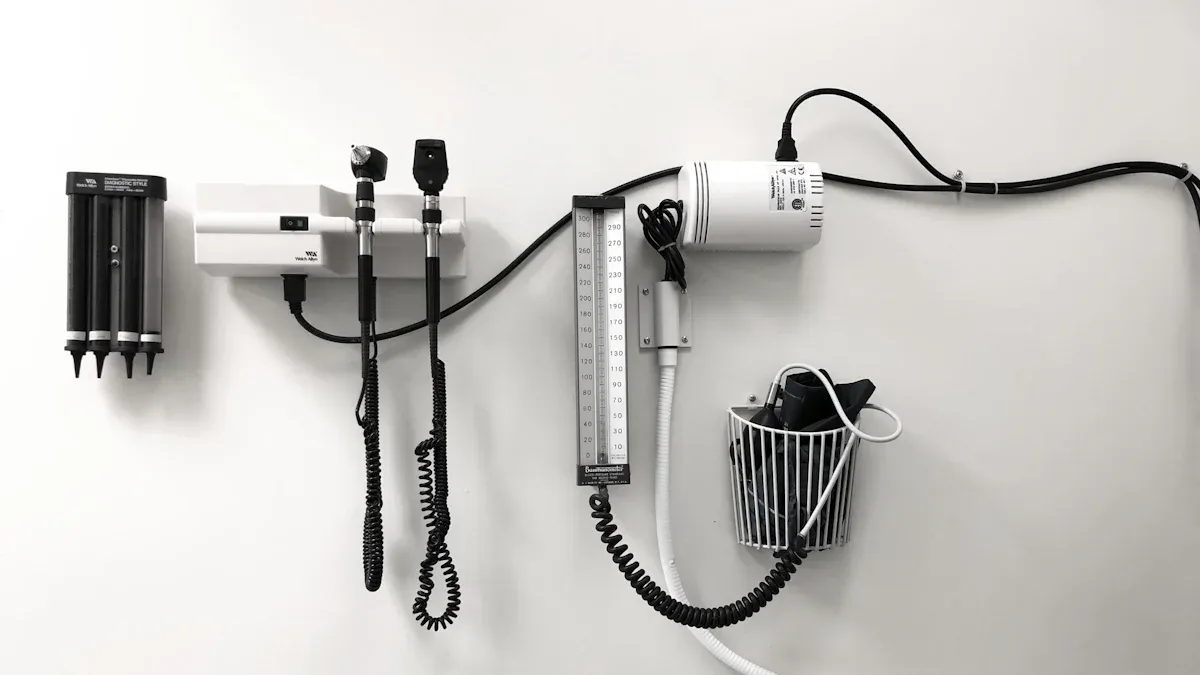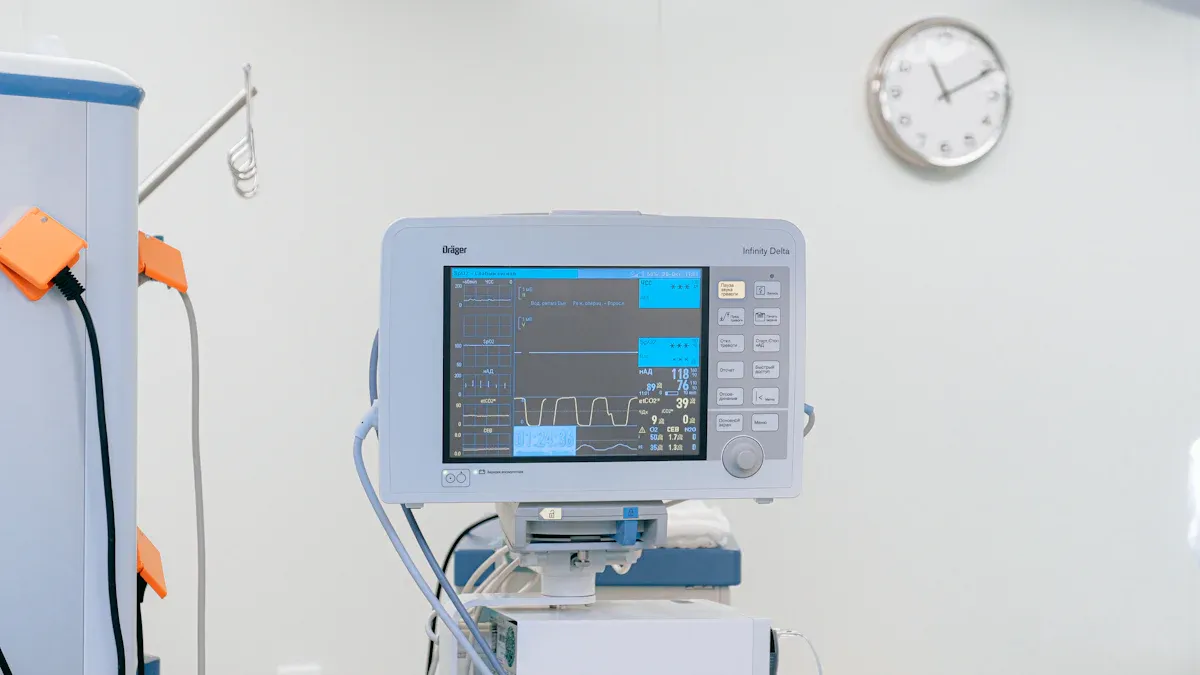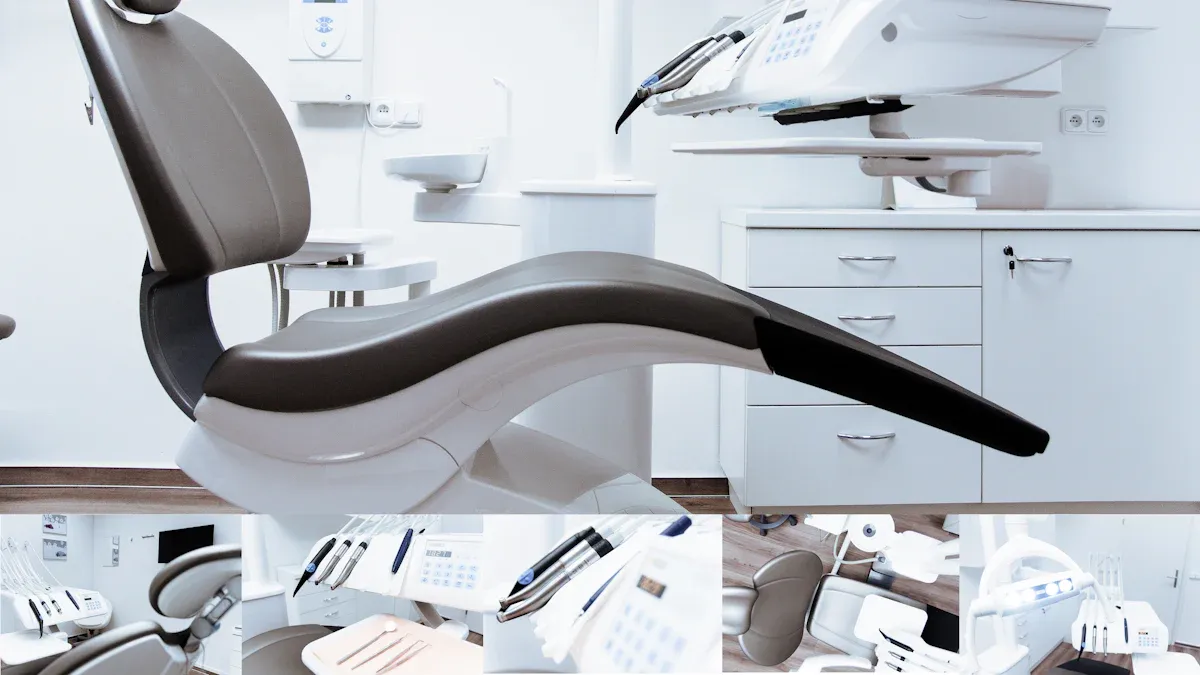How Shape Memory Nitinol Tubing Enhances Medical Device Design

Shape memory nitinol tubing has transformed the design of medical devices by offering unparalleled functionality and performance. Its unique ability to return to a pre-defined shape after deformation, combined with superelasticity, allows for precise deployment in minimally invasive procedures. Nitinol tubing achieves a strain recovery of 5.62% with a recovery ratio of 98%, making it ideal for applications like stents and guidewires. Advanced manufacturing processes ensure consistent dimensions, such as 10 × 0.457 mm, which enhance reliability in neurovascular interventions. These properties not only improve patient care but also align with the growing demand for innovative solutions in modern healthcare.
Key Takeaways
Shape memory nitinol tubing can go back to its shape after bending. This makes it great for medical tools like stents and guidewires.
Nitinol is safe for the body and doesn’t rust. This lowers the chance of bad reactions in medical devices.
Nitinol tubing is strong and bends easily. It can last through millions of uses without breaking, even under stress.
Using nitinol tubing in small surgeries helps patients heal faster. It also lowers the chances of problems during recovery.
New discoveries in materials are creating more uses for nitinol tubing. This helps make better medical tools and robot-assisted surgeries.
Unique Properties of Shape Memory Nitinol Tubing

Shape Memory and Superelasticity
Shape memory nitinol tubing stands out due to its remarkable shape memory property and superelasticity. These features allow the tubing to return to its original shape after deformation, making it ideal for medical devices requiring precision and adaptability. When heated, nitinol reverts to a pre-defined configuration, a characteristic that has revolutionized applications like stents and vascular implants.
Nitinol tubing can undergo significant deformation without permanent damage, thanks to its superelasticity.
Engineering analyses, such as the bend free recovery (BFR) test, validate its ability to recover its shape under stress.
Differential scanning calorimetry (DSC) further quantifies the shape memory effect, ensuring consistent performance in critical medical applications.
This combination of properties enables nitinol tubing to perform reliably in dynamic environments, such as the human body, where flexibility and precision are essential.
Note: The shape memory property of nitinol tubing has transformed interventional cardiology, allowing stents to compress for insertion and expand to provide structural support.
Biocompatibility and Corrosion Resistance
The biocompatibility of nitinol tubing ensures its safety for use in medical devices that come into direct contact with human tissue. This property is critical for healthcare applications, as it minimizes the risk of adverse reactions. Nitinol's corrosion resistance further enhances its reliability, especially in environments exposed to bodily fluids.
Electropolished nitinol tubing demonstrates superior corrosion resistance compared to oxidized tubing.
Long-term studies confirm its ability to maintain integrity under challenging conditions.
Its biocompatibility in healthcare applications makes it a preferred material for devices like guidewires and catheters.
The biocompatibility of nitinol, combined with its resistance to corrosion, ensures that medical devices remain safe and effective over extended periods. These attributes make nitinol tubing indispensable in modern healthcare.
Durability and Flexibility
Nitinol tubing excels in durability and flexibility, outperforming many other materials used in medical devices. Accelerated fatigue testing under clinically relevant conditions demonstrates its ability to withstand millions of cycles without failure. This resilience is crucial for devices subjected to repetitive mechanical stress, such as surgical tools and implants.
Property | Nitinol | Other Materials |
|---|---|---|
Durability | Withstands millions of fatigue cycles | Varies, often lower durability |
Flexibility | Superelastic, returns to original shape | Limited flexibility |
Application | Ideal for stents and guidewires | Used in various devices |
Nitinol tubing maintains its structural integrity even after repeated use.
Its superelasticity allows for significant deformation without permanent damage.
Long-term studies validate its reliability in demanding surgical environments.
The combination of durability and flexibility ensures that nitinol tubing can adapt to the complex and dynamic conditions of the human body, making it a cornerstone of medical innovation.
Applications of Nitinol Tubing in Medical Devices

Stents and Vascular Implants
Nitinol tubing has revolutionized the design of stents and vascular implants, offering unmatched performance in minimally invasive procedures. Its shape memory and superelastic properties allow stents to compress for insertion and expand precisely at the target site, ensuring optimal blood flow. Self-expanding stents, made from nitinol, adapt seamlessly to the dynamic environment of blood vessels, reducing the risk of restenosis.
Drug-eluting stents, which combine nitinol's mechanical advantages with medication delivery, further enhance patient outcomes by preventing arterial blockages. The tubing's biocompatibility minimizes the risk of rejection, while its corrosion resistance ensures long-term durability. These attributes make nitinol tubing indispensable in advanced medical devices for cardiovascular care.
Tip: Nitinol-based implants, such as stents, are particularly effective in treating conditions like peripheral artery disease and coronary artery disease due to their adaptability and reliability.
Guidewires and Catheters
Guidewires and catheters represent critical applications in the medical field where nitinol tubing excels. The tubing's flexibility and durability enable guidewires to navigate complex anatomical pathways with precision. Catheters, often used in urological and cardiovascular procedures, benefit from nitinol's ability to maintain structural integrity under stress.
Comparative studies highlight the superior performance of nitinol-based guidewires and catheters. For instance:
Study Focus | Key Findings |
|---|---|
Mechanical Properties | Evaluates stiffness and friction coefficient of various guidewires and catheters. |
Performance Testing | Introduces a method for estimating forces applied by guidewires and catheters during urological procedures. |
Simulation Model | Utilizes a computer-controlled test stand to simulate urological environments, reflecting performance under realistic conditions. |
These findings underscore nitinol's role in enhancing the functionality of guidewires and catheters, making them essential components of advanced medical devices.
Orthopedic Devices
Orthopedic devices incorporating nitinol tubing offer significant advantages over traditional materials like steel or titanium. Nitinol's unique combination of flexibility, durability, and biocompatibility makes it ideal for load-bearing implants and surgical tools. Its ability to withstand repeated bending and twisting ensures long-lasting performance, even under high mechanical stress.
Recent studies comparing nitinol tubing to traditional materials reveal its superior properties:
Property | Nitinol Tubing | Traditional Materials (e.g., Steel) |
|---|---|---|
Tensile Strength | Remarkable tensile strength | Varies, generally lower |
Resistance to Deformation | Excellent, ideal for load-bearing | Limited, prone to deformation |
Corrosion Resistance | Superior, breakdown potential up to 1000 mV | Lower, varies significantly |
Biocompatibility | High, reduces rejection rates | Varies, often lower |
Flexibility | Superior flexibility and durability | Limited flexibility |
Durability | High, withstands repeated bending | Lower, prone to fatigue |
Orthopedic implants, such as spinal rods and bone fixation devices, benefit from nitinol's ability to conform to the body's movements while maintaining structural integrity. This adaptability reduces the risk of complications and improves patient recovery times.
Note: Nitinol in medical device applications continues to expand, with orthopedic devices leading the way in leveraging its unique properties for better patient outcomes.
Robotic-Assisted Surgeries
Robotic-assisted surgeries represent a groundbreaking advancement in modern medicine. These procedures rely on precision, flexibility, and adaptability to navigate the intricate structures of the human body. Shape memory nitinol tubing plays a pivotal role in enhancing the performance of surgical robots, enabling them to achieve unparalleled accuracy and efficiency.
Nitinol tubing's unique properties make it an ideal material for robotic surgical systems. Its shape memory and superelasticity allow robotic arms to maintain their structural integrity while performing complex maneuvers. These characteristics ensure that surgical robots can adapt to the dynamic environment of the human body without compromising precision.
Shape memory enables nitinol tubing to return to its original configuration after deformation, ensuring consistent performance during repetitive movements.
Superelasticity provides the flexibility required to navigate complex anatomical pathways while maintaining stiffness for precise manipulation.
The combination of stiffness and flexibility enhances the accuracy of robotic arms, reducing the risk of errors during surgery.
The integration of nitinol tubing into robotic-assisted systems has significantly improved surgical outcomes. Surgeons can perform minimally invasive procedures with greater control and reduced trauma to surrounding tissues. This advancement has led to shorter recovery times and improved patient satisfaction.
Tip: Nitinol tubing's ability to balance flexibility and stiffness makes it a critical component in robotic-assisted surgeries, where precision and adaptability are paramount.
The use of nitinol tubing in robotic-assisted surgeries continues to evolve. As material science advances, the potential for even more sophisticated surgical systems grows. These innovations promise to further enhance the capabilities of robotic-assisted procedures, setting new standards for precision and patient care.
Advantages of Nitinol Tubing in Healthcare
Minimally Invasive Procedures
Nitinol tubing plays a pivotal role in enabling minimally invasive procedures, which have become a cornerstone of modern healthcare. Its shape memory and superelastic properties allow medical devices to navigate complex anatomical pathways with precision. These attributes reduce trauma to surrounding tissues, making nitinol tubing indispensable in minimally invasive surgical tools.
Medical devices like stents and guidewires benefit from nitinol's ability to compress for insertion and expand at the target site. This adaptability ensures accurate placement and optimal performance during procedures. Additionally, nitinol tubing's flexibility allows surgeons to perform intricate maneuvers without compromising device integrity.
Tip: Minimally invasive procedures using nitinol tubing often result in shorter recovery times and lower risks of complications, enhancing patient outcomes significantly.
Enhanced Durability and Longevity
Durability is a defining characteristic of nitinol tubing, making it ideal for medical devices subjected to repetitive mechanical stress. Accelerated fatigue testing confirms its ability to withstand millions of cycles without failure. This resilience ensures that devices like stents, catheters, and orthopedic implants maintain their structural integrity over extended periods.
Nitinol tubing's superelasticity further enhances its longevity. It can endure significant deformation and return to its original shape, reducing the likelihood of device failure. Long-term studies validate its reliability in demanding healthcare environments, where durability is critical for patient safety.
Feature | Nitinol Tubing | Other Materials |
|---|---|---|
Fatigue Resistance | Withstands millions of cycles | Lower resistance |
Structural Integrity | Maintains shape under stress | Prone to deformation |
Longevity | High durability | Varies, often lower |
This combination of durability and flexibility ensures that nitinol tubing remains a preferred material for medical devices requiring long-term performance.
Cost-Effectiveness
Nitinol tubing offers significant cost advantages in healthcare, despite the price volatility of its key components, nickel and titanium. Its unique properties reduce the need for frequent device replacements, lowering overall healthcare costs. Additionally, its ability to enable minimally invasive procedures minimizes hospital stays and recovery times, further reducing expenses.
Several financial reports highlight the economic benefits of using nitinol tubing:
Nickel accounts for approximately 50% of nitinol's composition, with annual price volatility ranging from 14-27%.
A 20% increase in nickel prices can lead to a 10-12% rise in manufacturing costs.
Consumption values and revenues generated by organizations in the shape memory alloys market underscore nitinol's financial viability.
Despite these fluctuations, the long-term savings achieved through nitinol tubing's durability and performance outweigh initial production costs. Its cost-effectiveness makes it a valuable material for medical devices in modern healthcare systems.
Note: The economic advantages of nitinol tubing extend beyond manufacturing, as its role in minimally invasive procedures reduces patient care costs significantly.
Improved Patient Outcomes
Nitinol tubing has significantly enhanced patient outcomes in modern healthcare by improving the performance and reliability of medical devices. Its unique properties, such as shape memory and superelasticity, enable devices to function with greater precision and adaptability. These advancements have led to better procedural success rates and reduced recovery time for patients undergoing minimally invasive procedures.
Medical devices incorporating nitinol tubing demonstrate superior outcomes compared to those using alternative materials. For example, the SARIS trial, which evaluated nitinol-based stents, reported a 100% recanalization rate and a 55% rate of patients achieving a modified Rankin Scale (mRS) score of ≤2, indicating favorable recovery. In contrast, a multicenter study involving 1,122 patients using multimodal therapy achieved a lower recanalization rate of 74%. The SARIS trial also showed no cases of in-stent restenosis, highlighting nitinol's durability and effectiveness.
Study/Trial | Sample Size | Recanalization Rate | mRS ≤ 2 Rate | Mortality Rate | In-Stent Restenosis |
|---|---|---|---|---|---|
SARIS trial | 20 patients | 100% (TIMI 2/3) | 55% | 35% | No |
Multicenter study | 1122 patients | 74% (multimodal therapy) | N/A | N/A | N/A |
These findings underscore the critical role of nitinol tubing in improving healthcare outcomes. Devices made from nitinol not only enhance procedural success but also minimize complications, leading to shorter hospital stays and better long-term health for patients. By enabling minimally invasive procedures, nitinol tubing reduces trauma and accelerates recovery, further solidifying its importance in medical innovation.
Note: The integration of nitinol tubing into medical devices continues to transform healthcare, offering patients safer and more effective treatment options.
Future Potential of Nitinol Tubing in Medical Innovation
Advances in Material Science
Recent advancements in material science are unlocking new possibilities for nitinol tubing, enhancing its properties and expanding its applications in medical devices. Multi-memory technology now allows a single nitinol structure to exhibit multiple shape memories, enabling the creation of complex and adaptive medical devices. This innovation is particularly beneficial for advanced surgical instruments that require precise and dynamic functionality.
Hybrid materials, which combine nitinol with other substances, are further improving mechanical properties. These combinations enhance strength, flexibility, and biocompatibility, making nitinol tubing suitable for a broader range of medical applications. Enhanced cooling techniques have also emerged, improving actuation cooling and ensuring consistent performance. These advancements increase the frequency capabilities of nitinol-based devices, making them more reliable in demanding healthcare environments.
Advancement | Description |
|---|---|
Multi-memory technology | Enables multiple shape memories within a single structure, allowing for complex medical device designs. |
Hybrid materials | Combines nitinol with other substances to enhance mechanical properties and expand applications. |
Enhanced cooling techniques | Improves actuation cooling, ensuring consistent performance and increasing frequency capabilities. |
These innovations demonstrate the transformative potential of nitinol tubing in shaping the future of medical device design.
Expanding Applications
The versatility of nitinol tubing continues to drive its adoption in emerging medical device segments. Its shape memory properties allow devices to maintain structural integrity under stress or temperature changes, making it indispensable in cardiovascular applications. For example, nitinol tubing has revolutionized stent design, enabling optimal blood flow and reducing the risk of restenosis.
Beyond cardiovascular care, nitinol tubing is finding applications in robotics and wearable medical devices. Its unique characteristics enhance the functionality of robotic-assisted systems, enabling precise and minimally invasive procedures. In wearable devices, nitinol tubing improves patient comfort by adapting to body movements while maintaining durability.
Nitinol tubing enhances device performance in dynamic environments.
It reduces complications in cardiovascular procedures by ensuring consistent device behavior.
Its integration into robotics and wearables highlights its adaptability and potential for innovation.
These expanding applications underscore the critical role of nitinol tubing in advancing healthcare technologies.
Integration with Smart Technologies
The integration of nitinol tubing with smart technologies is paving the way for next-generation medical devices. Researchers are exploring how nitinol can interact with sensors and actuators to create intelligent systems capable of real-time adjustments. For instance, nitinol-based devices equipped with embedded sensors can monitor physiological changes and adapt their behavior accordingly.
This synergy between nitinol tubing and smart technologies is particularly promising for advanced surgical instruments. Devices that combine nitinol's shape memory and superelasticity with real-time data processing can achieve unparalleled precision and efficiency. These innovations are expected to improve surgical outcomes and reduce recovery times for patients.
Smart nitinol devices can self-adjust based on environmental feedback.
Integration with IoT platforms enables remote monitoring and control of medical devices.
The combination of nitinol tubing and smart technologies is driving the development of personalized healthcare solutions.
As smart technologies continue to evolve, the potential for nitinol tubing in medical innovation will only grow, offering new possibilities for patient care and device functionality.
Shape memory nitinol tubing has become a cornerstone in medical device innovation, offering unmatched properties that drive advancements in healthcare. Its ability to enable minimally invasive procedures and improve patient outcomes has positioned it as a critical material in modern medicine.
The global nitinol medical devices market is projected to grow from $20.4 billion in 2024 to $35.8 billion by 2033.
Nitinol implants are expected to reach $1.6 billion by 2027, with a compound annual growth rate of 8.7%.
These figures underscore its expanding role in medical technology. As applications diversify and material science evolves, nitinol tubing will continue to shape the future of healthcare innovation.
FAQ
What makes nitinol tubing unique for medical devices?
Nitinol tubing offers shape memory, superelasticity, and biocompatibility. These properties allow it to adapt to dynamic environments, such as the human body, while maintaining structural integrity. Its ability to recover its original shape after deformation makes it ideal for minimally invasive procedures.
How does nitinol tubing improve patient outcomes?
Devices made from nitinol tubing enhance procedural precision and reduce complications. Its flexibility minimizes tissue trauma during minimally invasive surgeries, leading to faster recovery times. Clinical studies also show higher success rates and durability compared to devices made from traditional materials.
Is nitinol tubing safe for long-term use in the body?
Yes, nitinol tubing is highly biocompatible and corrosion-resistant. These attributes ensure its safety for long-term implantation. Electropolishing further enhances its surface properties, reducing the risk of adverse reactions and ensuring reliable performance in medical applications.
What are the main applications of nitinol tubing in healthcare?
Nitinol tubing is widely used in stents, guidewires, catheters, orthopedic implants, and robotic-assisted surgical systems. Its adaptability and durability make it suitable for cardiovascular, urological, and orthopedic procedures, as well as advanced surgical technologies.
How does nitinol tubing contribute to cost-effectiveness in healthcare?
Nitinol tubing reduces the need for frequent device replacements due to its durability and fatigue resistance. It also enables minimally invasive procedures, which shorten hospital stays and recovery times. These factors lower overall healthcare costs despite the material's higher initial production expenses.
See Also
Nitinol Tubing's Impact on the Future of Medical Devices
Nitinol Tubing's Contribution to Modern Medical Technology
Understanding Nitinol Tubing Uses in Healthcare Innovations

